-
 Iron tsuba of round form, slightly convex, decorated with persimmon (kaki), simplified Genji-kō (incense game symbol) and halves of plum blossoms (ume) in brass inlay on both sides, and with part of bellflower (kikyo) in openwork. Outer rim, seppa-dai, bellflower openwork, and kozuka-ana outlined with brass inlay; traces of lacquer to surface. The symbolic meaning alludes to Chapter 20: Asagao (朝顔, the bellflower or "morning face") of Tale of Genji by Murasaki Shikibu (11th century AD). The events take place in the 9th lunar month (Nagatsuki) and involve the following poetry by Prince Genji: saku hana ni / utsuru chō na wa / tsutsumedomo / orade sugiuki / kesa no asagao [I would not have it said / that my heart has turned toward / a flower in bloom — / yet how hard it is to pass / without plucking a “morning face”!]. Measurements: H: 76.6 mm; W: 76.3 mm; Th.: 3.6 mm (seppa-dai), 3.0 mm (rim) Time: Late Muromachi (1514 – 1573).
Iron tsuba of round form, slightly convex, decorated with persimmon (kaki), simplified Genji-kō (incense game symbol) and halves of plum blossoms (ume) in brass inlay on both sides, and with part of bellflower (kikyo) in openwork. Outer rim, seppa-dai, bellflower openwork, and kozuka-ana outlined with brass inlay; traces of lacquer to surface. The symbolic meaning alludes to Chapter 20: Asagao (朝顔, the bellflower or "morning face") of Tale of Genji by Murasaki Shikibu (11th century AD). The events take place in the 9th lunar month (Nagatsuki) and involve the following poetry by Prince Genji: saku hana ni / utsuru chō na wa / tsutsumedomo / orade sugiuki / kesa no asagao [I would not have it said / that my heart has turned toward / a flower in bloom — / yet how hard it is to pass / without plucking a “morning face”!]. Measurements: H: 76.6 mm; W: 76.3 mm; Th.: 3.6 mm (seppa-dai), 3.0 mm (rim) Time: Late Muromachi (1514 – 1573). -
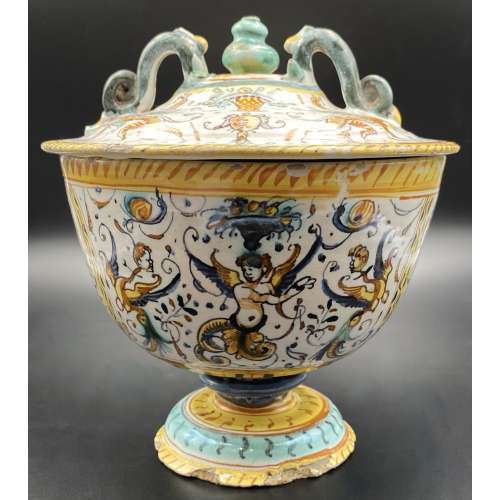 Tin-glazed earthenware footed lidded cup decorated with winged creatures and grotesque paintings, Bachus and Cupid inside. Minor losses Diameter: 16 cm; Height: 18 cm. Attributed to Deruta, Italy, c. 1600.
Tin-glazed earthenware footed lidded cup decorated with winged creatures and grotesque paintings, Bachus and Cupid inside. Minor losses Diameter: 16 cm; Height: 18 cm. Attributed to Deruta, Italy, c. 1600. -
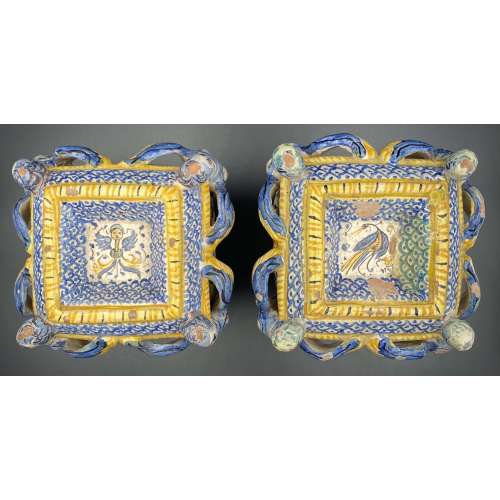 Tin-glazed earthenware salt cellars decorated with winged creatures and grotesque paintings. Restored, losses. Size: 16 x 16 cm; Height: 2.5 cm. Attributed to Deruta, Italy, c. 1600.
Tin-glazed earthenware salt cellars decorated with winged creatures and grotesque paintings. Restored, losses. Size: 16 x 16 cm; Height: 2.5 cm. Attributed to Deruta, Italy, c. 1600. -
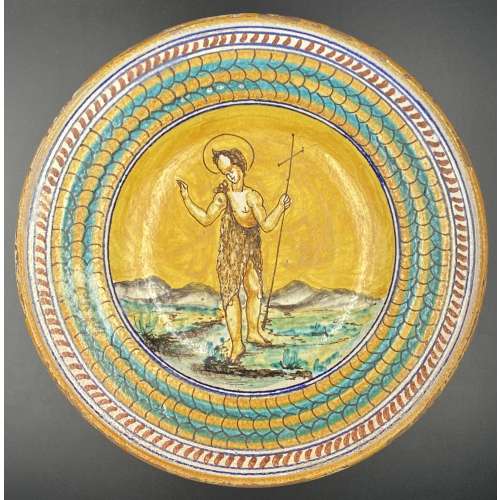 Tin-glazed earthenware polychrome plate of round form, decorated with a figure of John the Baptist wearing clothes of camel's hair with a tall cross in his left hand and with a halo over his head, walking in a desert with hills on the background. The lip is decorated with circles and scales, base with concentric circles. Diameter: 23 cm; Height: 4 cm.
Tin-glazed earthenware polychrome plate of round form, decorated with a figure of John the Baptist wearing clothes of camel's hair with a tall cross in his left hand and with a halo over his head, walking in a desert with hills on the background. The lip is decorated with circles and scales, base with concentric circles. Diameter: 23 cm; Height: 4 cm. -
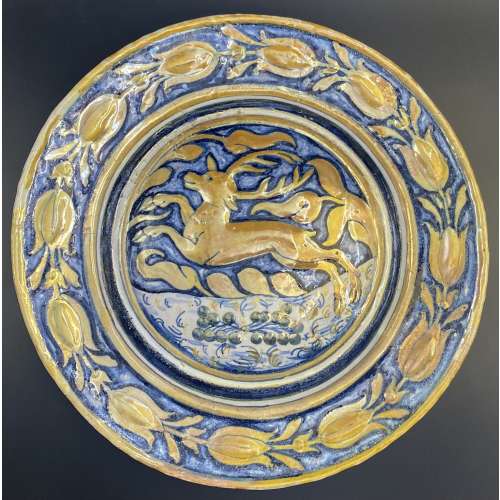 Tin-glazed earthenware plate with lustre in blue and ochre, decorated in relief with a deer in the centre and a chain of tulips on the lip; base signed “CK” in blue. Restored. Diameter: 24.8 cm; Height: 2.5 cm. Attributed to Gubbio (Umbria, Italy), 1520-1550.
Tin-glazed earthenware plate with lustre in blue and ochre, decorated in relief with a deer in the centre and a chain of tulips on the lip; base signed “CK” in blue. Restored. Diameter: 24.8 cm; Height: 2.5 cm. Attributed to Gubbio (Umbria, Italy), 1520-1550. -
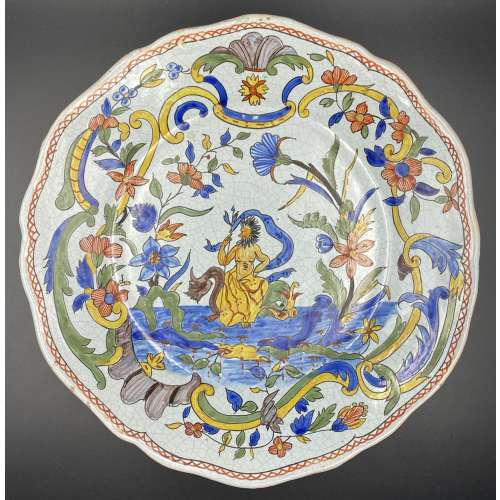 Tin-glazed earthenware polychrome plate with a scalloped rim, decorated with a triton riding a dolphin, surrounded by flowers and arabesque. Diameter: 24.5 cm; Height: 3.5 cm.
Tin-glazed earthenware polychrome plate with a scalloped rim, decorated with a triton riding a dolphin, surrounded by flowers and arabesque. Diameter: 24.5 cm; Height: 3.5 cm. -
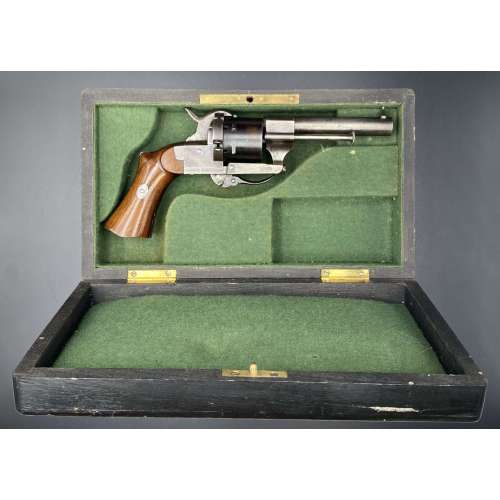
Lefaucheux model 1858 pin-fire self-cocking revolver with ejector rod, folding trigger and polished walnut grips, manufactured in Paris.
Stamped on barrel: E. LEFAUCHEUX BRte S.G.D.G. À PARIS.
Serial number LF 9018; in a wooden case. Dimensions: Case: 23 x 13 x 6 cm; L: 20.5 cm; H: 9 cm; Barrel: 9 cm. Eugene Lefaucheux (French, 1820 – 1871) was the son of Casimir Lefaucheux (French, 1802 – 1852). -
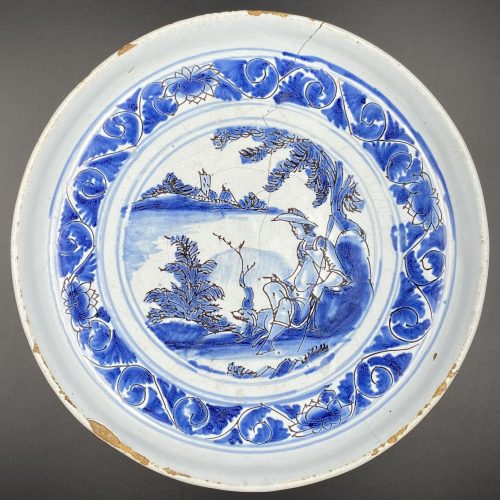 Nevers faience footed plate with a hunter and his dog on a mound, in blue over white. Dimensions: Diameter 22.3 cm; H: 3.5 cm. Seller's description: Plat rond en faïence à décor en camaïeu bleu d'un personnage et son chien sur un tertre feuillagé dans un médaillon, frise d'entrelacs. Fin XVIIème.
Nevers faience footed plate with a hunter and his dog on a mound, in blue over white. Dimensions: Diameter 22.3 cm; H: 3.5 cm. Seller's description: Plat rond en faïence à décor en camaïeu bleu d'un personnage et son chien sur un tertre feuillagé dans un médaillon, frise d'entrelacs. Fin XVIIème. -
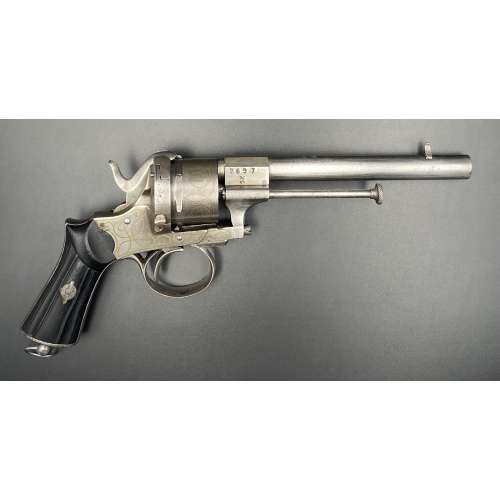 Serial number 8697, barrel 14.5 cm, calibre 9 mm Lefaucheux M-1858 double-action pin-fire revolver manufactured in the late 1860-s. Produced in France with no retailers marking but having French proofs on front of the cylinder and right side of barrel trunnion. The metal remains in the white with small gold wire inlays. Fluted 2 piece ebony grips. This pattern has been observed in civil war photographs and excavated from battlefields and camps in the United States. Dimensions: L: 25 cm; H: 13 cm; Barrel: 14.5 cm.
Serial number 8697, barrel 14.5 cm, calibre 9 mm Lefaucheux M-1858 double-action pin-fire revolver manufactured in the late 1860-s. Produced in France with no retailers marking but having French proofs on front of the cylinder and right side of barrel trunnion. The metal remains in the white with small gold wire inlays. Fluted 2 piece ebony grips. This pattern has been observed in civil war photographs and excavated from battlefields and camps in the United States. Dimensions: L: 25 cm; H: 13 cm; Barrel: 14.5 cm. -
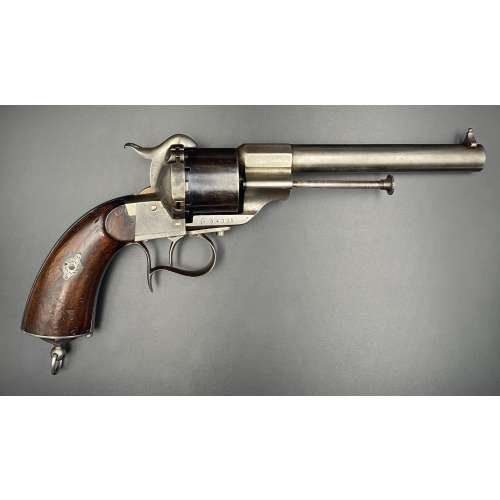
Six shot 11-millimetre Lefaucheux Brevete M-1854 single-action pin-fire revolver, serial #34755. French large calibre revolver features octagon to round barrel, non-fluted cylinder, walnut grips with the heavy pommel.
Manufactured in Paris.
Dimensions: L: 29.5 cm; H: 15.5 cm; Barrel: 16 cm. -
 Iron tsuba of round form, tapering from centre to the rim, decorated with eight roundels – circular emblems of flowers and/or family crests (mon) made of cast brass, pierced and chiselled in kebori, and with flat brass inlay (hira-zōgan) of water plantain (omodaka) and seaweed all over the plate. Hitsu-ana outlined in brass. Four positive silhouette roundels are 3-, 6-, 9-, and 12 – pointing crests/flowers; four negative silhouette roundels – bellflower, cherry and plum blossoms. Yoshirō school (Kaga-Yoshirō). Unsigned. The Momoyama or early Edo period, end of the 16th to the first half of the 17th century (1574-1650). Size: H: 88.3 mm; W: 88.7 mm; Thickness 4.0 mm (Seppa-dai), 3,2 cm (rim). Other Kaga-Yoshiro tsuba in this collection: TSU-0334: 7.7 cm; TSU-0342.2017: 89.6 cm; TSU-0344: 8.1 cm; TSU-0329: 8.0 cm; TSU-0376.2018: 8.1 cm; TSU-0379.2018: 8.2 cm. We see that the usual size is about 8 cm; larger pieces, such as this one and TSU-0342.2017 dedicated to Hachiman, are rare. Article about Yoshiro tsuba.
Iron tsuba of round form, tapering from centre to the rim, decorated with eight roundels – circular emblems of flowers and/or family crests (mon) made of cast brass, pierced and chiselled in kebori, and with flat brass inlay (hira-zōgan) of water plantain (omodaka) and seaweed all over the plate. Hitsu-ana outlined in brass. Four positive silhouette roundels are 3-, 6-, 9-, and 12 – pointing crests/flowers; four negative silhouette roundels – bellflower, cherry and plum blossoms. Yoshirō school (Kaga-Yoshirō). Unsigned. The Momoyama or early Edo period, end of the 16th to the first half of the 17th century (1574-1650). Size: H: 88.3 mm; W: 88.7 mm; Thickness 4.0 mm (Seppa-dai), 3,2 cm (rim). Other Kaga-Yoshiro tsuba in this collection: TSU-0334: 7.7 cm; TSU-0342.2017: 89.6 cm; TSU-0344: 8.1 cm; TSU-0329: 8.0 cm; TSU-0376.2018: 8.1 cm; TSU-0379.2018: 8.2 cm. We see that the usual size is about 8 cm; larger pieces, such as this one and TSU-0342.2017 dedicated to Hachiman, are rare. Article about Yoshiro tsuba. -
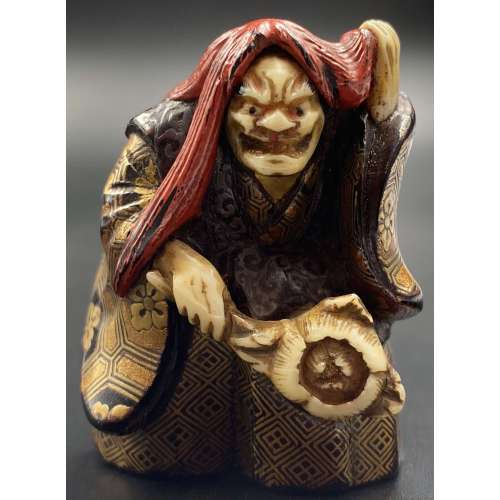 An actor dressed as a witch, with red hair, a gold patterned costume with tortoiseshell and flower lozenge design, and an inlaid ivory mask, hands, feet and flower blossom. Signature to the bottom: Kogyoku [光玉]. Dimensions: 4.17 x 3.07 x 2.99 cm. Provenance: Collection of Gloria and Joe Kurilecz. Sold by Eldred's, on August 25, 1993, Lot #699.
An actor dressed as a witch, with red hair, a gold patterned costume with tortoiseshell and flower lozenge design, and an inlaid ivory mask, hands, feet and flower blossom. Signature to the bottom: Kogyoku [光玉]. Dimensions: 4.17 x 3.07 x 2.99 cm. Provenance: Collection of Gloria and Joe Kurilecz. Sold by Eldred's, on August 25, 1993, Lot #699. -
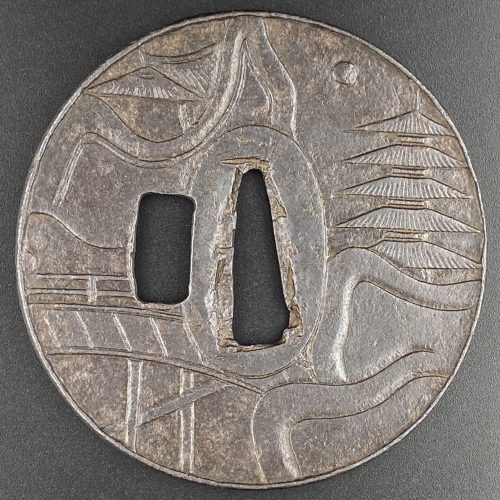
The thin iron plate of round form and black colour carved in sukidashi-bori with the design of rocks, waves, bridge, mountain pavilion and 5-storey pagoda under the moon, on both sides, alluding to Todai-ji temple in Nara. Slightly rounded rectangular hitsu-ana probably pierced later. Very narrow raised rim as usual in katsushi tsuba. In a modern wooden box.
Late Muromachi period, 16th century. Dimensions: 81.1 x 79.5 x 3. mm (seppa-dai), 2.2 mm (base plate), 4.4. (rim).Reference: “Art of the Samurai” on page 232, №140: ”Kamakura tsuba with Sangatsu-do tower and bridge. Muromachi period, 16th century. 83 mm x 80 mm. Unsigned. Tokyo National Museum. The mountain pavilion and bridge carved in sunken relief on the iron tsuba – both part of Tōdai-ji, a temple in Nara – are detailed in fine kebori (line) engraving. As a result of the chiselling used to create the relief, the ground of the piece is relatively thin”. Also page 41 in Tsuba Kanshoki. Kazutaro Torogoye, 1975 [LIB-1480.2018].
This tsuba is very much similar to TSU-0384. -
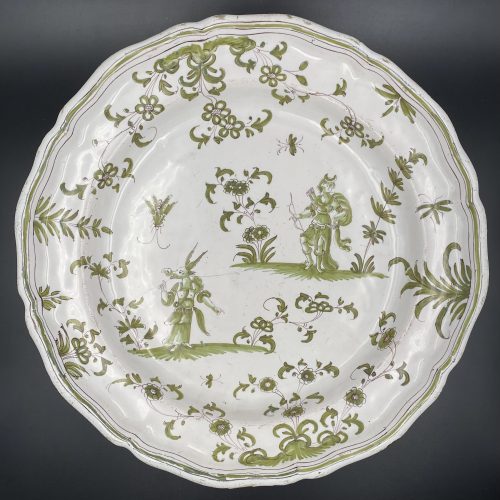 Moustiers faience plate: tin-glazed earthenware plate with a scalloped rim, with green monochrome grotesque decoration of a whimsical creature and a female archer, surrounded by flowering vegetation and insects. Marked "X" on the bottom. "Joseph Fouque/Jean-Francois Pelloquin, started in 1749, used an"X" in its pottery mark". Diameter: 31 cm; Height: 4 cm.
Moustiers faience plate: tin-glazed earthenware plate with a scalloped rim, with green monochrome grotesque decoration of a whimsical creature and a female archer, surrounded by flowering vegetation and insects. Marked "X" on the bottom. "Joseph Fouque/Jean-Francois Pelloquin, started in 1749, used an"X" in its pottery mark". Diameter: 31 cm; Height: 4 cm. -
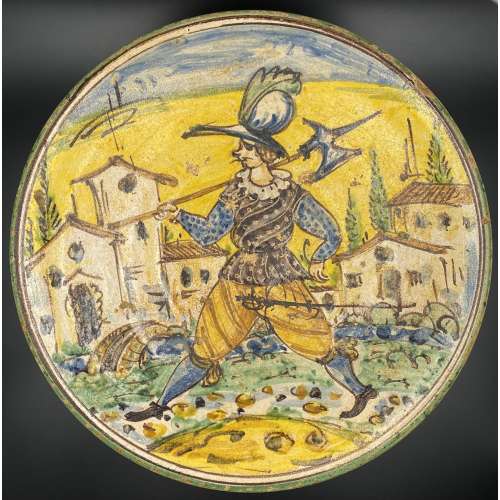 Footed round dish depicting a gentleman in an urban landscape holding a halberd in a style of "Arlecchino di Montelupo". Unsigned. Chips to the bottom. Diameter: 32.5 cm; Height: 4.5 cm. Produced in Italy, in Montelupo, about 20 kilometres (12 miles) southwest of Florence. 17th century, probably the first half. "After 1630, the year of the great plague, the number of potters reduced considerably and in the second half of the 1600s production suffered a drastic slump, potteries that specialized in a more prestigious production disappeared completely leaving only the potteries that produced kitchenware and terracotta objects" [www.tuscany-charming.it].
Footed round dish depicting a gentleman in an urban landscape holding a halberd in a style of "Arlecchino di Montelupo". Unsigned. Chips to the bottom. Diameter: 32.5 cm; Height: 4.5 cm. Produced in Italy, in Montelupo, about 20 kilometres (12 miles) southwest of Florence. 17th century, probably the first half. "After 1630, the year of the great plague, the number of potters reduced considerably and in the second half of the 1600s production suffered a drastic slump, potteries that specialized in a more prestigious production disappeared completely leaving only the potteries that produced kitchenware and terracotta objects" [www.tuscany-charming.it]. -
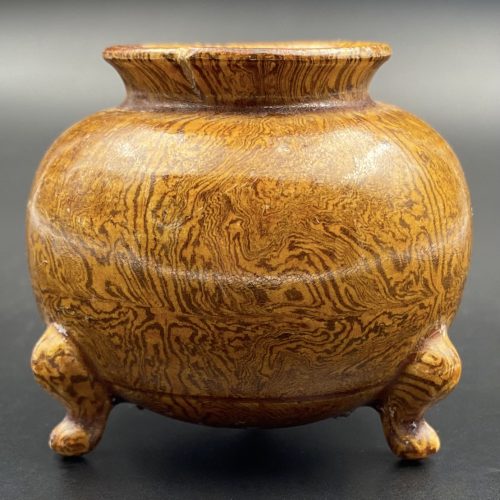 Small amber-glazed marbled (Jiaotai) pottery tripod censer. Inside the glaze is monochrome because the clay itself is not marbled. Spur marks on the bottom. Small chip on a lip. China, Henan province, the Tang dynasty [唐朝] (618 – 907). Diameter: 6.3 cm; Height: 5.5 cm.
Small amber-glazed marbled (Jiaotai) pottery tripod censer. Inside the glaze is monochrome because the clay itself is not marbled. Spur marks on the bottom. Small chip on a lip. China, Henan province, the Tang dynasty [唐朝] (618 – 907). Diameter: 6.3 cm; Height: 5.5 cm. -
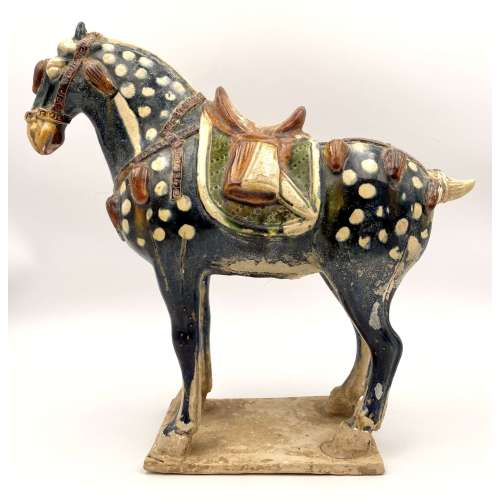 Moulded and sculpted earthenware horse with dark-blue, cream-dappled body, green and cream saddle pad, amber and cream saddle, and amber harness details. H: 28 cm.
Moulded and sculpted earthenware horse with dark-blue, cream-dappled body, green and cream saddle pad, amber and cream saddle, and amber harness details. H: 28 cm. -
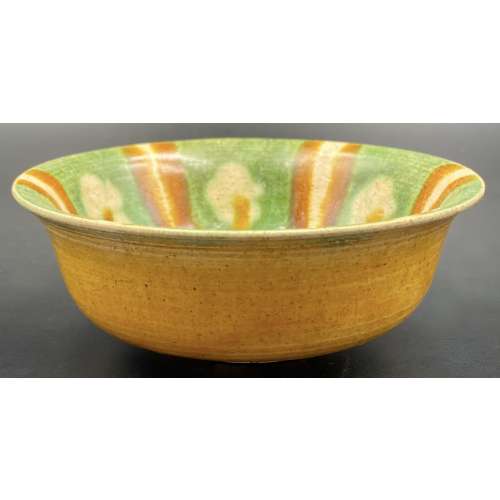 Small stoneware cup with rounded sides raising from a short foot to an inverted rim; glazed inside with a cream and brown six-petal design on a green background with cream and brown stylized flowers. Amber glaze outside, blue bottom, foot unglazed. Dia: 10 cm; H: 4 cm.
Small stoneware cup with rounded sides raising from a short foot to an inverted rim; glazed inside with a cream and brown six-petal design on a green background with cream and brown stylized flowers. Amber glaze outside, blue bottom, foot unglazed. Dia: 10 cm; H: 4 cm.


